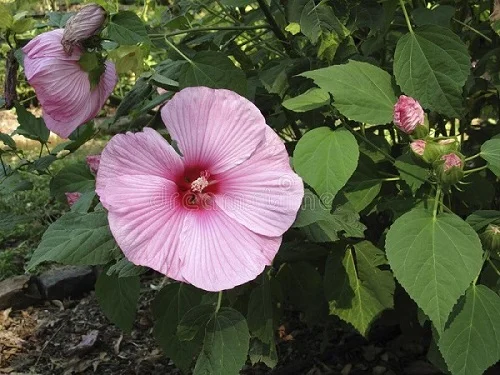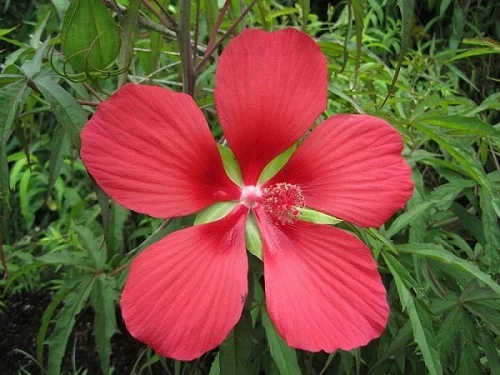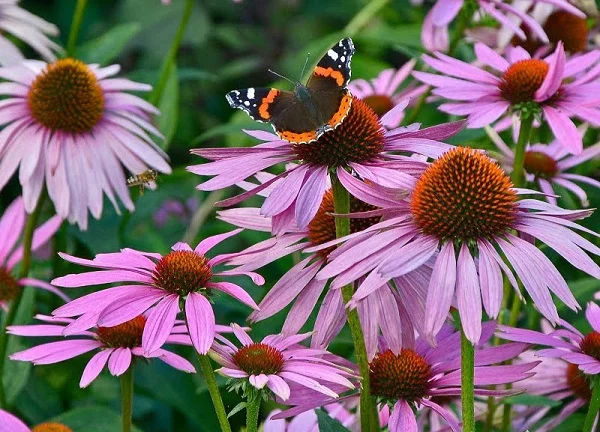How to Grow and Care for Rose of Sharon | Hibiscus syriacus Care Guide
Some links in this post may be affiliate links
Rose of Sharon (Hibiscus syriacus) is a hardy deciduous shrub which bears large trumpet-shaped flowers with prominent yellow-tipped white stamens and green or yellowish-green, alternate, ovate leaves. The leaves are about 3 inches long and palmately veined. They have three distinct lobes with coarsely-toothed margins.
Shrub Althea is an upright, vase-shaped plant whose stems and branches do not branch much unless they are pruned. The stems arise about 1.5 inches above the ground which gives the plant the vase shape.
Hibiscus syriacus can tolerate air pollution, heat, humidity, poor soil and drought. It has naturalized very well in suburban areas and is considered slightly invasive in some regions.
Unlike the Tropical Hibiscus rosa-sinensis (Rose of China), Rose of Sharon is a cold-hardy Hibiscus which is ideal for USDA Zones 5-9. The foliage dies in winter and comes back as the temperatures begin to warm up.
In the colder regions, the Syrian Hibiscus can be grown in containers where it can be brought inside in winter and placed in a brightly lit spot with 6-8 hours of sunshine daily.
The genus name, 'Hibiscus', is old Greek or Latin for 'mallow'. The species name, 'syriacus', is because it had been collected from gardens in Syria.
Hibiscus syriacus is the national flower of South Korea. It is considered by South Koreans to be a traditional symbol of the Korean people and culture. According to records, the leaves were brewed into a herbal tea and the flowers eaten in Korea.
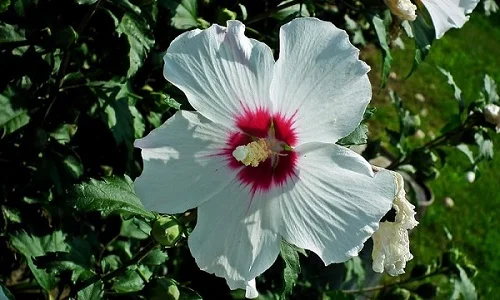
Photo Credit: Pxfuel
Botanical name: Hibiscus syriacus
Family: Malvaceae
Common names: Rose of Sharon, Syrian Hibiscus, Shrub Althea, Shrubby Rose-mallow
Origin
Hibiscus syriacus is native to south-central and southeast China.
Size
Rose of Sharon size ranges from 7-12 feet tall and 3-5 feet wide.
Flowers
Hibiscus syriacus flowers are five-petaled, about 3 inches diameter and are in solid colors of blue, mauve, purple,red, violet, white or bicolors with a different colored throat, depending on the cultivar.
Rose of Sharon flowers appear in summer to late fall and each lasts for 1-3 days. The flowers are produced in succession with a flower being produced each day. They attract butterflies, humming birds, bees and other pollinators.
Shrub Althea readily reseeds if the flowers are allowed to go into seed. Timely deadheading is recommended if the seeds are not required, otherwise, you may find the plant growing where it is not required.
Varieties
Numerous varieties (cultivars) of Hibiscus syriacus have been developed. Some of these include;
Blue Chiffon: which bears blue, semi-double flowers.
White Chiffon: which bears white, double flowers.
Lavender Chiffon: bears pale-lilac flowers.
Diana: bears single, white flowers.
Purple Pillar: bears semi-double flowers along the entire length of the stems.
Toxicity
Rose of Sharon is considered mildly toxic to humans and pets. The leaves contains low amounts of calcium oxalate crystals in the flowers, stems, and roots as indicated by Salman Khan Gurung on plantcraze.com. If ingested they can cause diarrhea, nausea, vomiting, and appetite loss.
Rose of Sharon Care
Rose of Sharon (Hibiscus syriacus) thrives in full sun with at least 6-8 hours of sunshine per day, average warmth, consistently moist, neutral to slightly acidic soil that is rich in organic matter.
Hibiscus syriacus requires deadheading of the spent flowers to keep the plant neat and to minimize pest and disease infestations. Annual cutting back is necessary to encourage new growth and promote flowering. Keep reading for more on these growing conditions and how to provide them.
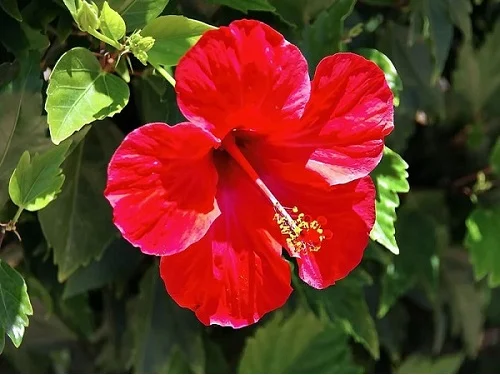
Photo Credit: Wallpaper Flare
Light Requirements
Rose of Sharon requires full sun with at least 6-8 hours of sunshine per day through out the growing season and a sunny window with 6-8 hours of direct sunshine daily in winter or instal grow lights for the container-grown plants.
Avoid shaded conditions where the plant may be overshadowed by tall buildings, trees or other large plants as they require full sun for the growth of the charming flowers.
However, where the summers are very harsh, grow the plant in a shaded spot to protect it from the hot afternoon sun which can cause scorching of the leaves.
Water Requirements
Water Rose of Sharon deeply and keep the soil consistently moist at all times during the growing season especially for the young plants.
Mature plants are drought-tolerant and may not require very frequent watering except in prolonged drought conditions. Therefore, water established plants when the top 2-3 inches of soil dry out.
For container-grown Syrian Hibiscus, ensure that the pot has a drainage hole and the soil is fast-draining to prevent the plant from sitting in soggy soil which can result in rotting and death of the plant.
Cut down on watering in the cold period as growth is reduced at this time, thus, the plant does not need much water for growth.
Temperature and Humidity
Rose of Sharon is tolerant to a wide range of temperatures. Average temperatures within the range of 13-300C are ideal for this plant. In winter, the plant is dormant.
To keep the soil warm in winter, apply a mulch on the soil surface but take care not to let the mulch come into contact with the stem to prevent rotting.
Container-grown Rose of Sharon should be brought indoors when the temperatures dip to -60C and positioned in a brightly lit spot. They should be provided with adequate humidity and good air circulation to minimize fungal diseases.
Fertilizer
Young Rose of Sharon needs regular feeding to promote healthy growth. Feed it every 3 weeks during the growing season with a balanced fertilizer but withhold feeding in the cold season to avoid fertilizer burn.
Established Syrian Hibiscus do not require regular feeding if the soil is rich in organic matter. You can opt to fertilize with a slow release fertilizer or incorporate about 2 inches of organic matter into the soil at the beginning of spring. Avoid overfeeding as it can lead to flowerbud drop.
Soil
Rose of Sharon is tolerant of a wide range of soil conditions. The best soil should be neutral to slightly acidic, well-drained and rich in organic matter.
Any soil that is low in organic matter should be ammended. Incorporate organic matter into the soil at planting time. The soil should be able to hold adequate moisture as the plants require consistently moist soil especially in the early stages of growth.
Where to Buy Rose of Sharon
Rose of Sharon Plants are readily available from Garden Centres at the beginning of spring. You may acquire these plants online from Etsy (Link to Etsy).
When to Plant Rose of Sharon in the Ground
The best time to plant Rose of Sharon in the ground is in spring after the risk of frost has passed and the soil has warmed up.
Planting Rose of Sharon in the Ground
Situate Rose of Sharon in a sheltered spot away from strong, chilling, drying winds inorder for it to thrive and reward you with a profusion of its pretty flowers.
Allow adequate space for the growth of the plant and keep it away from buildings and other structures.
Dig up the soil to a depth of about 18 inches to loosen it and get rid of all the weeds and other debris from the soil. Make sure that the soil is rich in organic matter or incorporate it where it is deficient.
Prepare planting holes twice as large as the rootballs of the plants at a spacing of 5-6 feet. Incorporate a handful of fully decomposed organic manure per hole.
Plant the Shrub Althea at the same depth as they were in their pot. Firm the soil around the root ball lightly.
Thoroughly water the plants and keep the soil moist until well established. Thereafter, water when the top 2-3 inches of soil dry out during the growing season but decrease watering in the cold season.
Repotting Container-grown Rose of Sharon
Where the conditions are not favourable for growing Rose of Sharon in the ground like in areas with harsh winters, you can grow the plants in containers.
Doing so allows you to move the plant to sunny spots during summer for the much needed sunlight and indoors next to a sunny window when the conditions are harsh in winter.
Repot Shrub Althea every 1-2 years at the beginning of the growing season (spring). Use a pot that is 2 sizes larger than the current one to provide adequate room for growth.
Make sure that the container(s) or pot(s) has a drainage hole to prevent the soil from getting soggy to prevent root-rot and eventual loss of the plant(s).
Slip the Rose of Sharon out of its pot and place it in the center of the new pot at the same soil level as it was in the previous pot and back fill with fresh, rich, free-draining soil.
Do not fill the pot completely but allow a space of about 1 inch from the rim for watering purposes to avoid spillage.
Wet the soil thoroughly until water comes out through the drainage hole(s) and keep the soil moist until the plants are well established.
Thereafter, water deeply during the growing season (summer) when the top 2-3 inches of soil dry out. Reduce watering in the cold season (winter).
Pruning Rose of Sharon
Pruning Rose of Sharon involves cutting back the stems two-third way above the ground in spring to encourage new growth and blooming. Cutting back promotes new growth from which the flower buds emerge Cutting back, encourages the growth of more compact bushes and more blooms as blooms are borne on new wood.
Pinch off the growing tips to encourage branching into a more compact, bushy plant. Cut away any dead wood to keep the plant neat and also reduce pests and disease infestation. Deadhead spent flower if seeds are not needed to keep the plant tidy as well as discourage self-seeding.
Propagation
Rose of Sharon (Hibiscus syriacus) is easily propagated from stem cuttings at the beginning of the growing season (spring or early summer) when new growth has begun.
How to propagate Rose of Sharon from stem cuttings
Take 3-5 inches stem cuttings from a healthy Rose of Sharon by cutting just below a leaf node.
Strip off the leaves from the lower 2-3 inches of the stem and dip the lower end in a rooting hormone to hasten rooting.
Insert the cutting in moist, free-draining, rooting soil in a small pot (about 4 inches wide) and lightly firm the soil around the cutting.
Cover the set up with a clear plastic bag to create a greehouse effect (increase humidity and warmth) inorder to fasten rooting.
Place the set up in a well-lit, warm (about 150C) place away from direct sunlight to avoid cooking the plants.
Maintain the soil slightly moist until the stem cuttings have rooted. Rooting may take 6-8 weeks and is indicated by growth of new leaves.
Tug at the cuttings a little, any resistance indicates rooting has occurred. Once rooted, remove the plastic cover. Transplant the new plant to the garden when well established.
How to Start Rose of Sharon from Seeds
Rose of Sharon can be started from seeds indoors about 12 weeks before the last frost in spring.
Sow each seed about 1/2 inch deep in well-drained, seed starting soil. Lightly moisten the soil and place the set up in a warm (about 23-260C), brightly-lit spot away from direct sunlight.
Maintain the soil moist through out until the new plants are well established. Germination of the seeds should occur in about 3-4 weeks. The seedlings can be transplanted outdoors in spring when the threat of frost has passed.
Before transplanting, harden off the seedlings to outdoors growing conditions by gradually acclimating them. Gradually reduce watering and place them in a slightly brighter spot over a period of 2 weeks until they can withstand full sun.
Rose of Sharon Winter Care
Rose of Sharon is a cold-hardy Hibiscus which will die in winter and come back in spring as the temperatures begin to get warm. For protection against harsh winters, apply a mulch on the soil surface to keep the roots warm.
Uses of Rose of Sharon
Rose of Sharon can be used as a specimen landscape plant, foundation or hedge plant. It can also be grown as a large patio container plant.
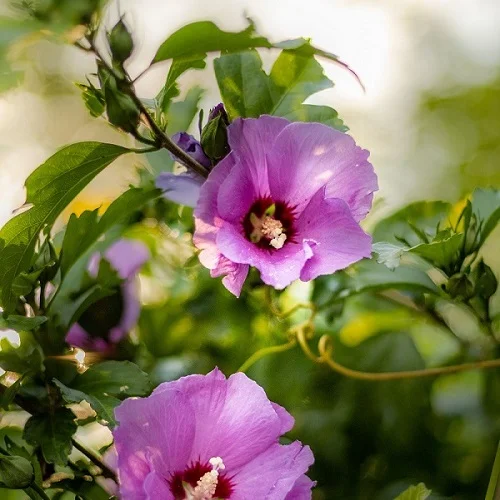
Photo Credit: Pexels
Rose of Sharon Growing Problems
Rose of Sharon (Hibiscus syriacus) problems include lack of blooms, leaf and flowerbud drop, yellow leaves, pests among others. Keep reading for more on these problems and how to fix them.
Lack of blooms
Lack of blooms in Rose of Sharon is caused by two possible reasons. One possible reason for lack of blooms is too little light. Position the plant in a sunny spot and ensure that it will receive 6-8 hours of direct sunlight per day while protecting it from harsh afternoon sun.
The second possible reason for lack of blooms in Shrub Althea is failure to prune (cutback) the plant. Cutback the plant annually in spring to to encourage new growth as blooms are borne on new growth.
The third possible reason for lack of blooms in Syrian Hibiscus is insufficient phosphorous in the soil. Phosphorous is an essential element in flower production therefore, feed the plant with a phosphorous-rich, water soluble fertilizer.
Leaf and flowerbud drop
Leaf and flowerbud drop (shedding) in Rose of Sharon is due to underwatering during the growing season. Though the plant is considered drought-tolerant, it cannot withstand prolonged periods of drought. Water the plant deeply when the top 2-3 inches of soil dry out and do not allow it to dry out for a prolonged period of time.
Yellow leaves
Yellow leaves in Rose of Sharon are an indication of overwatering or soggy soil. Ensure that the soil is fast draining to prevent excessive retention of water.
For container grown Shrub Althea, ensure that the pot has adequate drainage holes and that the soil drains easily to prevent it from getting soggy.
Pests
Common pests in Rose of Sharon are aphids, whiteflies and Japanese Bettles. Spray the plant with an insecticidal soap or neem oil to get rid of the pests. Ensure to follow the manufacturer's recommendations.
You liked it? Share on social media.
Related Content
Amazon Associates Disclosure
Homeplantsguide.com is a participant in the Amazon Services LLC Associates Program, an affiliate advertising program designed to provide a means for sites to earn advertising fees by advertising and linking to amazon.com.
